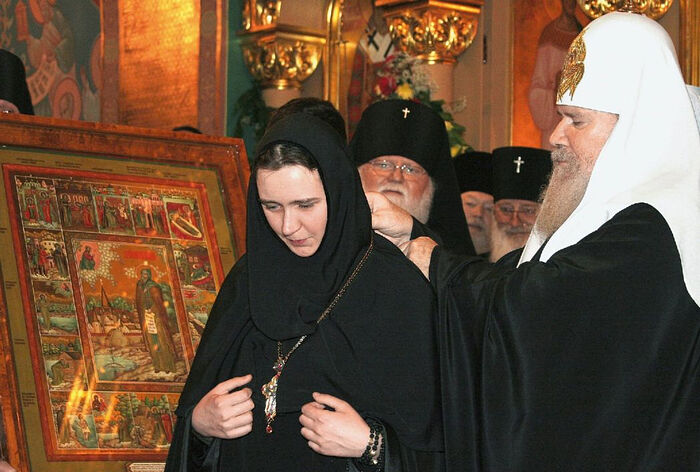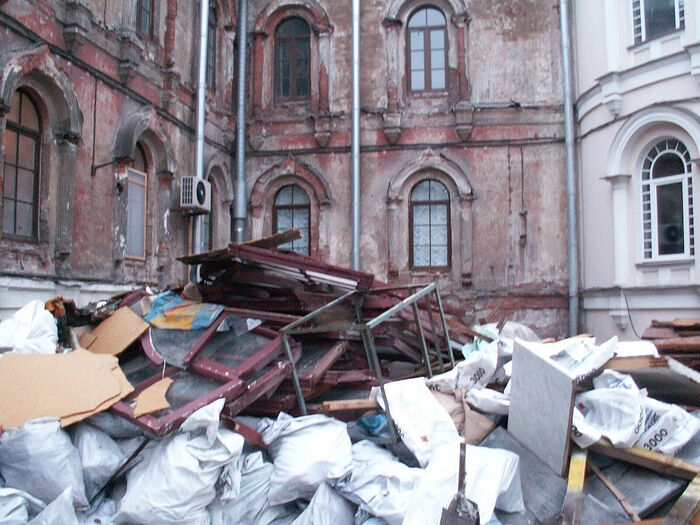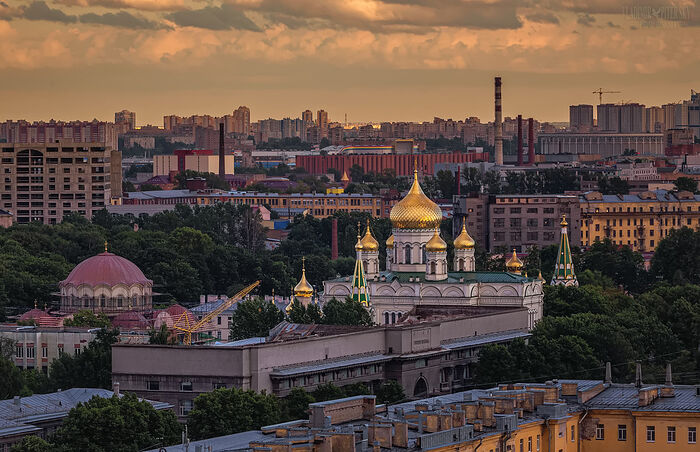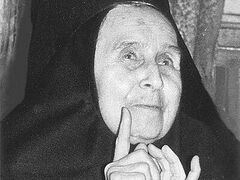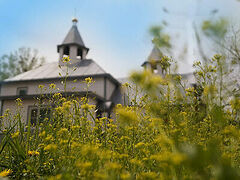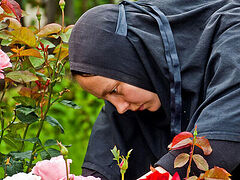This November, the Holy Resurrection Novodevichy Convent in St. Petersburg is celebrating the twenty-fifth anniversary of its revival, and on November 18, its mother-superior, Abbess Sophia (Silina), celebrated her fiftieth birthday.
 Holy Resurrection Novodevichy Convent
Holy Resurrection Novodevichy Convent
The spiritual world is not indifferent to us
About thirty years ago, Julia (Mother Sophia’s secular name) Silina had already chosen the path of monastic life. But her tonsure was preceded by the following event. Then, in the early 1990s, when much of everyday life in the country was falling apart and the Church was just reviving, the fathers of the Holy Trinity-St. Sergius Lavra began to petition for the return to the Church of the Lavra’s dependency in St. Petersburg. Julia, a student of the Department of law at St. Petersburg State University, was asked to help them.
While in Moscow, she and her mother went to the Lavra to study the details, but they arrived late in the evening and found that the Holy Trinity Cathedral was closed... They had no opportunity to venerate St. Sergius’ relics. But consolation soon followed: As if in reality, Julia saw in a very vivid dream St. Sergius’ reliquary and the saint himself standing nearby... The venerable father said distinctly, “Wait”.
Remarkably, on the feast of St. Sergius four years later, in the Holy Trinity St. Sergius Monastery1 near St. Petersburg on the shores of the Gulf of Finland, the future abbess was tonsured into the small schema. Some of the first sisters of the convent, then parishioners of St. Sergius’ Monastery, were tonsured there as well. Thus, Abba Sergius is especially venerated at the Holy Resurrection Novodevichy Convent—his icons can be found there in all the churches and in the refectory. In 2014, the house Church of the Apparition of the Most Holy Theotokos to St. Sergius was consecrated in the convent.
Mother Sophia had number of significant dreams, which afterwards were confirmed as true. For example, before her tonsure, when the world often rises up against aspiring monastics with all its temptations, the future abbess saw in a dream and elder she had never seen before. Later, on the portraits hanging at the St. Petersburg Theological Academy where she had taught law from her student years, she recognized Metropolitan Anthony (Melnikov; † 05.29.1986) as the patron who had appeared to her. The bishop was not tonsured into the schema in his lifetime, but we can’t know how people will appear before the Lord in the next life. St. Paisios the Hagiorite used to say, “When monks meet Christ, the schema will be taken away from some and given to others.” “For God, the great schema is of the spirit, which a person acquires during his lifetime,” Mother Sophia remarks. Vladyka spoke to her then as to an old acquaintance, although she hadn’t known him personally. He appeared and clearly responded to her inner hesitations and questions, strengthening her in choosing the monastic path. How astounded she was when she was given Vladyka Anthony’s paraman2 with the main instruction to all monastics: “I bear my Lord’s wounds on my body.” The future abbess was tonsured with this paraman.
The Holy Resurrection Novodevichy Convent has a host of heavenly patronesses from among the sisters who struggled here before the 1917 Revolution. There were over 400 nuns here when the convent was closed. Almost all of them were sent into exile, some were martyred, and some of them were canonized as new martyrs or new confessors—for example, the Venerable Martyr Seraphima (Gorshkova).
However, the nuns are confident that those of the sisters exiled from the convent after the Revolution but not canonized by the earthly Church were glorified by the Lord for their suffering anyway. Even before gaining access to the convent’s complex—then occupied by the Research Institute of Electrical Engineering, with a formidable security checkpoint covered with metal, like armor—the future Abbess Sophia had a dream...
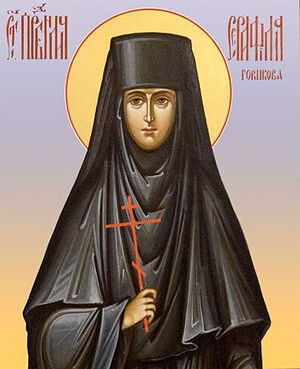 Venerable Martyr Seraphima (Gorshkova) A spring garden was all flooded with meltwater, from which columns protruded (like those that mark foundations before construction begins) connected by ropes around the perimeter. There she suddenly met nuns emerging one after another from the water, in pure, radiant garments. Their outer-cassocks were dazzling-white like snow at bright noonday in a clear and sunny winter... Nearby, Metropolitan John (Snychev; who was still alive) was standing with a vicar bishop. By that time, Met. John had already blessed Julia Silina, a lawyer at the St. Petersburg Theological Academy, to start working on the legal return of the Novodevichy Convent to the Church...
Venerable Martyr Seraphima (Gorshkova) A spring garden was all flooded with meltwater, from which columns protruded (like those that mark foundations before construction begins) connected by ropes around the perimeter. There she suddenly met nuns emerging one after another from the water, in pure, radiant garments. Their outer-cassocks were dazzling-white like snow at bright noonday in a clear and sunny winter... Nearby, Metropolitan John (Snychev; who was still alive) was standing with a vicar bishop. By that time, Met. John had already blessed Julia Silina, a lawyer at the St. Petersburg Theological Academy, to start working on the legal return of the Novodevichy Convent to the Church...
“Fear Nothing—everything was prepared here before you.” Even now that the huge convent’s complex has been restored, Mother Sophia hears this voice and remembers this dream in detail…
She also caught fish with her hands in the water that flooded the garden.
“A catcher of men,
Saved from the sea of iniquity!
He who catches clean fish
From a hostile wave to a sweet life!”
This is one of the associations with her dream from the strophes of Presbyter Clement of Alexandria.
Later, the Abbot of Vatopedi Monastery, who brought the cincture of the Most Holy Theotokos to Russia (including to their convent), instructed her that an abbot (in her case, an abbess) should “catch monastics.”
Here is a suitable quote from Tertullian’s treatise on Baptism, which Mother Sophia likes to cite: “But we, little fishes, after the example of our ΙΧΘΥΣ3 Jesus Christ, are born in water, nor have we safety in any other way than by permanently abiding in water.” For her the image of a coenobitic monastery will remain associated with this life-giving element of water. “Water is a symbol of the beginning of life, a spiritual symbol of purification and an image of the Grace of God,” Mother Sophia shares her thoughts, noting that later, when she first entered the convent’s courtyard, she saw the same garden that she had seen in that dream... And during the first spring, it became clear that since there was no drainage there yet, with the melting of snow the whole garden was flooded...
“Why were there nuns in white robes?” then the lawyer Julia Silina, now abbess, asked her colleague at the St. Petersburg Theological Academy, Hieromonk (now Archimandrite) Nikolai (Paramonov).
He replied that on the evening of the night she had that dream, he had taken out particles of prosphora [at the table of oblation, in preparation for the Liturgy] for the repressed nuns, commemorating them by name... A little earlier, Metropolitan John (Snychev) had sent an elderly woman—Lyudmila Pavlovna Yagdanova—to Julia. She was a goddaughter of Abbess Theophania (Rentel), the last mother-superior before the convent was closed, and a close relative of her cell-attendant Nun Sergia (Arakcheeva). As a relative she was given access to the NKVD4 archives—and the list of the names of the arrested and exiled nuns, compiled by her for commemoration, based on the results of her work, fell into Julia’s hands, and she handed it over to Fr. Nikolai. Busy with so many things, she had forgotten about it...
“The sisters appeared in white robes because they are martyrs. The Lord prepared white robes in the Kingdom of Heaven for those who suffered for Him (cf. Rev. 7: 13–14),” Fr. Nikolai explained.
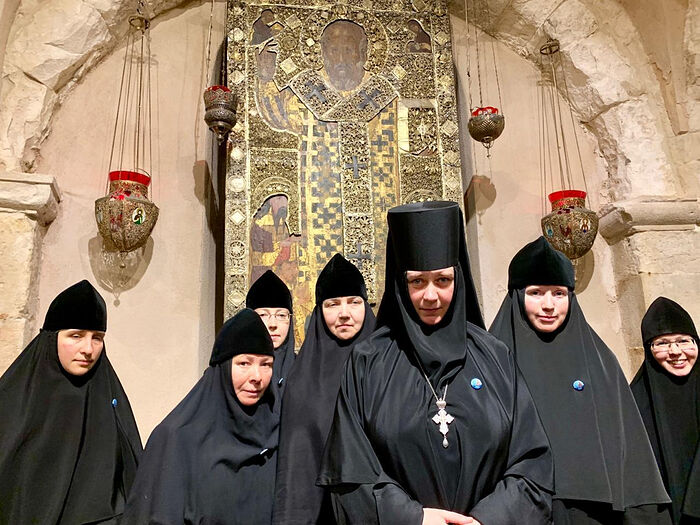 Abbess Sophia with her sisters
Abbess Sophia with her sisters
Even in the Soviet era, the legendary Abbesses Barbara (Trofimova) of Pyukhtitsa and Georgia (Shchukina) of Gorny Convent miraculously went through the aforementioned metal-covered checkpoint of the Research Institute of Electrical Engineering, which then occupied the Holy Resurrection Novodevichy Convent, unnoticed by anyone. They came here to find the graves of the former abbesses of the convent and pray at them... Then Mother Barbara took special care of the newly appointed young Abbess Sophia, and instructed her. Pyukhtitsa Convent had never been closed by the communists, and the monastic tradition was never interrupted there. But in the beginning, the buildings of the Holy Resurrection Novodevichy Convent didn’t even belong to the Church...
One day Mother Sophia came to Pyukhtitsa Convent to pray and seek advice from the “abbess- builder”, as Mother Barbara was called. There were so many obstacles to the revival of the convent then, and none of the tenants wanted to leave the ancient walls in the city’s center... And what else would the spiritually wise eldress have advised other than prayer to the Mother of God?! Mother Sophia begged tearfully for a solution to her misfortunes before the wonderworking Pyukhtitsa Icon of the Mother of God. This is one of the few icons on which the Theotokos is depicted standing on the ground… And at that very moment the Vice-Governor of St. Petersburg, Valery Nazarov, suddenly appeared next to Mother Sophia, immersed in prayer! It was he who then supervised the transfer of the convent to the Church in the city administration. It turned out that he was accompanying the Governor of St. Petersburg on a pilgrimage. So the problem was solved quickly. Moreover, the buildings were returned to the convent all at once.
However, there was a huge amount of work to be done... But the sisters already knew that the most important thing was prayer, and the Lord and the Mother of God would not leave them without help.
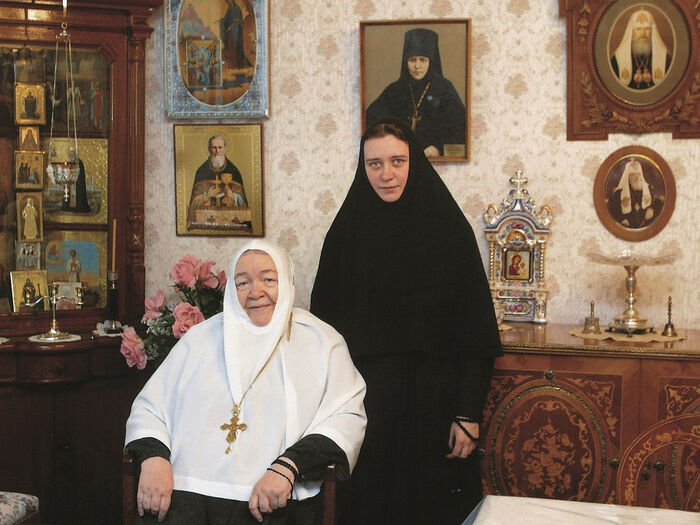 Abbess Sophia with Abbess Barbara (Trofimova) of Pyukhtitsa
Abbess Sophia with Abbess Barbara (Trofimova) of Pyukhtitsa
Signs of attention from Heaven
Another Heavenly patroness of the Holy Resurrection Novodevichy Convent is the Venerable Martyr Maria of Gatchina. She was not paralyzed, but she had such a condition that any movement caused her unbearable pain, so she had to lie almost motionless. Despite this infirmity, she was a very active and compassionate person! She prayed for everyone unceasingly, and an endless stream of people would come to her for advice, consolation, and the resolution of their problems. She lived exactly according to the testament of St. Seraphim of Sarov, who once appeared to Elder John (Krestiankin) and said, “Having been enslaved by the body, preserve your soul unenslaved.”
For some time after the uncovering of the relics of Nun-Martyr Maria of Gatchina, they remained in the Holy Resurrection Novodevichy Convent in St. Petersburg. And after they had been transferred to the site of the saint’s ascetic labors in the town of Gatchina (in Leningrad region), with the blessing of the ruling hierarch, part of the saint’s head remained in the convent. It was Mother Sophia (who had taken part in the uncovering of the saint’s main relics) who was destined to uncover the nun-martyr’s head from the grave (it was divided by prison doctors into three parts, apparently during an autopsy).
Sophia took some earth from the grave and sprinkled it on the area around the building of the St. Vladimir School—the school administration had long been unwilling to turn it over... Now a general education school5 is there under the care of the convent. All the issues were resolved chiefly by prayer, and “signs of attention” from Heaven came one after another...
One of the first signs was that the director of Medikor LLC, which once occupied this building, turned out to be a great-granddaughter of the pre-revolutionary warden of the St. Vladimir Cathedral in St. Petersburg. She, like almost all of her 100 employees, began to go to church after meeting Mother Sophia. And when for the first time the director’s secretary reported that the abbess was waiting for her, she expected to see a stately old woman—such as Mother Barbara (Trofimova), but she was at a loss when she saw in front of her a thin and very young lady in black. “For some reason I felt very sorry for her; I imagined how the revival of the convent would fall on her fragile shoulders…” Elena Pestova later recalled.
“Our relationship was interesting, and we confided in each other,” she related. “We met from time to time. Matushka would come for a short while and tell us about the convent’s restoration. She had many different problems. Sometimes she would just come to my office, sink into a chair and sit silently. I would understand that she was having a hard time.”
However, she was convinced again and again of the young abbess’s strong will and character.
“There was a difficult period when I asked matushka to put up with the loss of the building, but she didn’t bless it,” Elena Pestova recalls. “For almost twenty years, maintaining and renovating No. 104 [Moskovsky Avenue, St. Petersburg.—Ed.], we believed that someday it would return to its rightful owner—the Novodevichy Convent.”
And so it happened.
The clairvoyant elder Nikolai Guryanov also blessed them to “stand” for the convent, and he prayed for its revival, seeing through the decades and saying as he looked at pictures of blatant devastation, “What a wonderful, beautiful convent!”. But it’s quite another thing to find the strength to fight day after day to transform shabby, desolated buildings into a beautiful convent to the glory of God, and to somehow inspire others for over a decade to not doubt, to spare neither energy, time, nor funds... Besides, their neighbors had to take part in the reconstruction not only of building No. 104...
Investing in Light
“Novice Tatiana (now Nun Maria) once came to my office,” Elena relates, “and said categorically that money was urgently needed, and even mentioned a specific amount. I silently took it out of the safe, gave it to her, and she left. I was somehow uncomfortable with that situation. A week later the same sister came again...
“‘Come with me!’
“I thought it would be useless to refuse. I went to the convent with her. At that time all the windows in the Church of the Kazan Icon had been bricked up—there was a factory there in Soviet times, and the windows had been walled over. Novice Tatiana and I walked into the church, and suddenly I saw a miracle—a ray of sunlight from the altar window! That money had gone to install the first double-glazed window pane in the window opening, in place of those bricks. I was speechless with joy, and Novice Tatiana said:
“‘There is your money.’
“An important feeling was added to my joy: I understood what it means to help a convent. No donations will be wasted or spent on something else—they will serve people and help the donor to lay up his ‘treasures in Heaven’.”
In conclusion, Mother Sophia shared one more dream with us:
“Our convent in St. Petersburg stands at Moskovsky Avenue. Here I was riding on a tram. It was already dusk outside. Having ridden one stop past our convent, I got off the tram and ran towards the convent. Once I entered the gate, I suddenly saw that it was still noon there... One rarely remembers dreams so clearly. Sometime later, while rereading the notes of Abbess Thaisia (Solopova),6 I learned that she once had a similar dream: ‘If it is already twilight in the world,’ she explained, ‘then there is no sunset in monasteries.’ I think this is how the Lord strengthens us.”
“As priests joke in our troubled times in response to questions from parishioners who are incorrectly eschatologically minded (and we’re not talking about Christmas lights):
“‘Father, will there be the end of the world?’
“‘No, there will not.’
“‘Why?’
“‘Because there will be an end to darkness.’” 7

